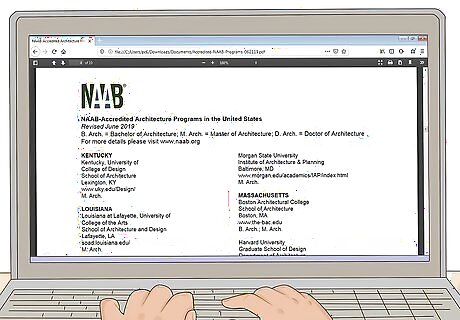
views
Prepare to Become an Architect

Understand the profession. Architecture involves more than an aptitude for drawing or basic carpentry. In fact, to call yourself an architect, you must first earn a license from a U.S. licensing board. This process involves earning a degree from an accredited program, gaining real-world experience, and passing a national exam. After earning a license, architects are involved in each phase of the process of creating a new structure—from conceiving an idea for the structure's design to communicating the plans to clients, overseeing the construction process, and ensuring the final structure will protect the public’s safety. Architects have the following talents and skills: Creative. Architects come up with original ideas for creating well-designed structures that complement their surroundings and meet their functional purpose. Every seemingly simple structure we encounter was dreamed up by an architect aiming for the sweet spot between beauty and functionality. Science-minded. Architecture is both an art and a science. In addition to designing buildings with elegance and beauty in mind, architects must understand how the different components of a building work together to create a sturdy, safe environment. An understanding of math and physics is essential. Great communicators. Architects must be able to effectively share their vision of a structure with those who will be constructing it. They are excellent at giving presentations, describing ideas clearly, and communicating with clients.

Decide what type of architect you want to be. Some architects work for firms and see projects through from conception to completion. Others use their talents and skills in different parts of the industry. Landscape architects have a background in plant sciences as well as architecture, and focus on how outdoor spaces play a complementary role. Some architects focus only on design, making sure the plans for a building follow building codes and meet the expectations of the client. Construction firms often hire architects as project managers who oversee the construction of structures. Some architects may focus on certain types of buildings, such as high-security facilities, hospitals, or schools. They may also work on the restoration of old buildings.

Talk to architects. As you're deciding whether you want to become an architect, talk with licensed professionals to get a sense of what it takes to have a career in architecture. Contact architecture firms in your area and ask if you can set up informational interviews. Ask for architecture program recommendations and other advice. Find a part-time job or internship at an architecture firm to get an even better sense of what the field is like.
Fulfill Educational and Training Requirements

Major in architecture. Research colleges and universities with strong architecture programs. Make sure the program you choose is accredited by the National Architectural Accrediting Board (NAAB). Some schools offer five-year programs that allow you to combine your bachelor's and master's degrees without the need to apply to separate programs. Art, math, environmental design, and other relevant majors are also appropriate choices to prepare you for a career in architecture. Just make sure you've taken the courses required to apply to graduate programs.

Get a graduate degree in architecture from a program accredited by the NAAB. If you did not enter a five-year combined bachelor's and master's program, you will need a master's in architecture after completing your undergraduate degree. Programs can focus on areas such as innovation, modern design, restoration, or even environmentally-friendly design. Research programs that meet your needs and personality.

Complete the Architectural Experience Program (AXP) administered by the National Council of Architectural Registration Boards (NCARB). Each state requires that potential architects gain professional experience before they are granted licensure. In most states, this requirement can be met by completing the AXP. Through the AXP, you'll learn how to safely and competently handle the scenarios you’ll face as an architect. With broad experience areas that reflect the current phases of practice, the program prepares you for everything from site design to project management. You can begin gaining experience toward the AXP after graduating high school. Time spent working in an architecture firm or volunteering for a design nonprofit may count toward the AXP.

Pass all divisions of the Architect Registration Examination (ARE). The ARE is currently available in two versions, ARE 4.0 and ARE 5.0, and assesses whether the licensure candidate has the knowledge and skills needed to fulfill the role of an architect. ARE 4.0 contains seven divisions and will be offered until June 30, 2018. ARE 5.0 features six divisions organized around the progression of a typical architecture project. Consider taking a seminar or study course to prepare for the ARE. Many valuable study resources can also be found at ncarb.org.
Getting Licensed as an Architect

Obtain your initial license. Contact the architecture registration board in the state where you will be practicing to find out the requirements you must meet for initial licensure, in addition to completing AXP and passing the ARE.

Get NCARB certification. Once you have your initial license, you can apply for an NCARB Certificate. This credential shows that you have met the highest professional standards possible, and allows you to work with clients across states and countries.

Start practicing. Depending on your educational path and personal interests, join a firm that focuses on a residential building, commercial building, or both. Consider operating as a consultant as a way to get your feet wet.




















Comments
0 comment